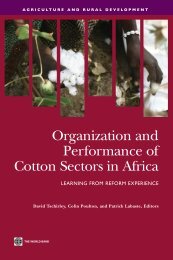Constraints to smallholders participation in Cassava value ... - aaacp
Constraints to smallholders participation in Cassava value ... - aaacp
Constraints to smallholders participation in Cassava value ... - aaacp
Create successful ePaper yourself
Turn your PDF publications into a flip-book with our unique Google optimized e-Paper software.
naturally less productive, but their lack of fertility could be overcome with small <strong>in</strong>vestments<strong>in</strong> fertilizer and lime.’Source: World Bank (World Bank 2009: 51-2).<strong>Cassava</strong> has been grow<strong>in</strong>g <strong>in</strong> importance <strong>in</strong> Zambia s<strong>in</strong>ce the era of market liberalisation <strong>in</strong> the 1990swhen support for maize was reduced, as part of a trend <strong>to</strong>wards agricultural diversification (Govereh,J., Chapo<strong>to</strong>, A. and Jayne, T.S. 2010). The evidence from the literature (Chitundu, M., Droppelmann,K. and Haggblade, S. 2009) and recent small scale research such as the study conducted by Cadoni(2010) has shown that cassava production us<strong>in</strong>g traditional, and <strong>in</strong>creas<strong>in</strong>gly improved varieties,currently contributes significantly <strong>to</strong> food security <strong>in</strong> the northern and western cassava belt (Luapula,Northern and Western Prov<strong>in</strong>ces). Follow<strong>in</strong>g susta<strong>in</strong>ed <strong>in</strong>terest by GoZ, donors and NGOs <strong>in</strong> thedevelopment and dissem<strong>in</strong>ation of IVs, there is evidence that cassava is <strong>in</strong>creas<strong>in</strong>gly appreciatedwith<strong>in</strong> the non-traditional cassava-grow<strong>in</strong>g southern and eastern maize belt for its drought <strong>to</strong>leranceand contribution <strong>to</strong> food security (Poole, N.D., Chitundu, M., Msoni, R. and Tembo, I. 2010).1.2 <strong>Cassava</strong> sec<strong>to</strong>r strategyIn the recent past various studies have been undertaken on the cassava <strong>value</strong> cha<strong>in</strong>. The ma<strong>in</strong>studies were commissioned by the Zambian National Task Force on Acceleration of <strong>Cassava</strong>Utilization (ACU) and the Food and Agriculture Organization. These studies identified five alternativesupply channels <strong>in</strong> Zambia’s <strong>Cassava</strong> Value Cha<strong>in</strong> as follows:1. Subsistence production - accounts for 85% of all cassava production <strong>in</strong> the country;2. Fresh cassava for human consumption - <strong>in</strong>volves farm households sell<strong>in</strong>g fresh surplus <strong>in</strong>nearby markets. It accounts for no more than 5% of <strong>to</strong>tal production, due <strong>to</strong> the speed ofdeterioration of cassava roots;3. Processed cassava for human consumption - nshima, the Zambian staple, composite flour,bread and biscuits, composite fritters, gari;4. Lives<strong>to</strong>ck feed - <strong>in</strong> trials dur<strong>in</strong>g 2006, results suggested that cassava-based rations producedweight ga<strong>in</strong>s equivalent <strong>to</strong> maize-based feeds and would prove commercially viable so longas cassava chips could be procured at the mill gate at 60% of the price of maize;5. Industrial uses - paper and wood <strong>in</strong>dustry <strong>in</strong> Lusaka and Copperbelt Prov<strong>in</strong>ces – and <strong>in</strong>export markets - which exploit the b<strong>in</strong>d<strong>in</strong>g properties of cassava flour and starch.These studies also identified the <strong>in</strong>herent constra<strong>in</strong>ts of the cassava <strong>value</strong> cha<strong>in</strong> that limited the fullrealization of its immense potential. These <strong>in</strong>cluded disaggregated and fragmented producers, poortransport and market <strong>in</strong>frastructure, an unsupportive policy framework, irregular supply,<strong>in</strong>consistent quality, high cyanide levels <strong>in</strong> poorly processed cassava, discoloration, high transactioncosts and uncompetitive pric<strong>in</strong>g.With the support of external organisations such as ITC and FAO, the local cassava sec<strong>to</strong>rstakeholders formed a sec<strong>to</strong>r strategy group under the auspices of the ACU compris<strong>in</strong>g producers,processors and manufacturers, f<strong>in</strong>ance agents and a range of public sec<strong>to</strong>r bodies, donors and NGOs.This approximates <strong>to</strong> the partnership type of a ‘deliberative forum’ for l<strong>in</strong>k<strong>in</strong>g stakeholders (Poul<strong>to</strong>n,C. 2009). The process of consultation bears some similarity also <strong>to</strong> participa<strong>to</strong>ry market cha<strong>in</strong>assessment method pioneered by the International Pota<strong>to</strong> Center CIP (Centro Internacional de laPapa, Lima, Peru) <strong>in</strong> the Andes and Uganda (Bernet, T., Thiele, G. and Zschocke, T. 2006; Devaux, A.,Hor<strong>to</strong>n, D., Velasco, C., Thiele, G., López, G., Bernet, T., Re<strong>in</strong>oso, I. and Ord<strong>in</strong>ola, M. 2009). GoZ,6
















